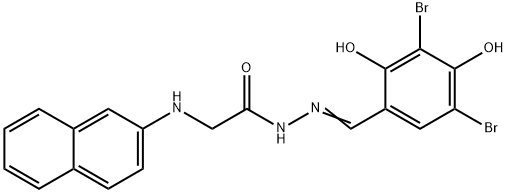GlyH-101
Synonym(s):CFTR Inhibitor II, GlyH-101 - CAS 328541-79-3 - Calbiochem;InSolution CFTR Inhibitor II, GlyH-101 - CAS 328541-79-3 - Calbiochem;N-(2-Naphthalenyl)-((3,5-dibromo-2,4-dihydroxyphenyl)methylene)glycine hydrazide
- CAS NO.:328541-79-3
- Empirical Formula: C19H15Br2N3O3
- Molecular Weight: 493.15
- MDL number: MFCD01532954
- SAFETY DATA SHEET (SDS)
- Update Date: 2024-11-15 21:27:52

What is GlyH-101?
Description
The cystic fibrosis (CF) gene encodes a cAMP-
The Uses of GlyH-101
N-2-Naphthalenyl-glycine 2-[(3,5-dibromo-2,4-dihydroxyphenyl)methylene]hydrazide is a glycine hydrazide that has recently been shown to block CFTR channels. However, its effects on cardiomyocytes are unknown. Studies have demonstrated that GlyH-101 blocks cardiac I Cl.PKA channels in a similar fashion to that reported for recombinant CFTR.
What are the applications of Application
CFTR Inhibitor II, GlyH-101 is a CFTR inhibitor
Definition
ChEBI: Glycine, n-2-naphthalenyl-, 2-[(3,5-dibromo-2,4-dihydroxyphenyl)methylene]hydrazide is a member of naphthalenes.
General Description
A cell-permeable glycinyl hydrazone compound that acts as a potent, selective and reversible open-channel blocker of CFTR with intermediate speed (<1 min; 95% inhibition at 50 μM; Ki = 4.3 μM in CFTR-expressing FRT cells for apical membrane Cl- current) and exhibits desirable aqueous solubility. Shown to produce inwardly rectifying CFTR Cl- currents with reduced mean channel open time and suggested to directly interact with the channel pore at the extracellular side of the membrane. Displays minimal effects on P-glycoprotein and non-CFTR-mediated Cl- currents, and is effective in nasal and intestinal epithelia in vivo.
Biochem/physiol Actions
Cell permeable: yes
storage
Store at -20°C
Properties of GlyH-101
| Melting point: | >300℃ (ethanol ) |
| Density | 1.73±0.1 g/cm3(Predicted) |
| storage temp. | = -70C |
| solubility | DMF:30.0(Max Conc. mg/mL);60.83(Max Conc. mM) DMF:PBS (pH 7.2) (1:1):0.5(Max Conc. mg/mL);1.01(Max Conc. mM) DMSO:57.58(Max Conc. mg/mL);116.75(Max Conc. mM) |
| form | Yellow solid |
| pka | 5.44±0.45(Predicted) |
| color | Light yellow to yellow |
Safety information for GlyH-101
Computed Descriptors for GlyH-101
New Products
4-AMINO-TETRAHYDRO-PYRAN-4-CARBOXYLIC ACID HCL 4-Aminotetrahydropyran-4-carbonitrile Hydrochloride (R)-3-Aminobutanenitrile Hydrochloride 3-(dimethylamino)-9,10-dimethoxy-1,3,4,6,7,11b-hexahydro-2H-pyrido[2,1-a]isoquinolin-2-one Iminostilbene 1,4-Dioxa-8-azaspiro[4.5]decane 5-Bromo-2-nitropyridine 4-(Dimethylamino)tetrahydro-2H-pyran-4-carbonitrile SODIUM AAS SOLUTION ZINC AAS SOLUTION BUFFER SOLUTION PH 10.0(BORATE) GOOCH CRUCIBLE SINTERED AQUANIL 5 BERYLLIUM AAS SOLUTION Methylcobalamin (vitamin B12) SODIUM METHYL PARABEN Diclofenac Sodium SODIUM VALPROATE Racecadotril XANTHAN GUM 5-Fluoro-2-iodo-3-methylphenol 4-(Cyanomethyl)-1-piperidineacetamide 6-Bromo-2-iodo-4-methyl-3-pyridinamine 5-Amino-3-bromo-2-chlorobenzeneacetic acidRelated products of tetrahydrofuran
You may like
-
 CFTR Inhibitor II, GlyH-101 CAS 328541-79-3View Details
CFTR Inhibitor II, GlyH-101 CAS 328541-79-3View Details
328541-79-3 -
 CFTR Inhibitor II, GlyH-101 CAS 328541-79-3View Details
CFTR Inhibitor II, GlyH-101 CAS 328541-79-3View Details
328541-79-3 -
 2-Chloro-5-(iodomethyl)pyrimidine 2268818-88-6 98%View Details
2-Chloro-5-(iodomethyl)pyrimidine 2268818-88-6 98%View Details
2268818-88-6 -
 2092793-98-9 98%View Details
2092793-98-9 98%View Details
2092793-98-9 -
 1360944-55-3 7-Methoxy-1H-indol-5-amine 98%View Details
1360944-55-3 7-Methoxy-1H-indol-5-amine 98%View Details
1360944-55-3 -
 2090480-14-9 98%View Details
2090480-14-9 98%View Details
2090480-14-9 -
![1-Methyl 2-bromo-5-[(1-carboxy-1-methylethyl)amino]benzoate 1651844-56-2 98%](https://img.chemicalbook.in//Content/image/CP5.jpg) 1-Methyl 2-bromo-5-[(1-carboxy-1-methylethyl)amino]benzoate 1651844-56-2 98%View Details
1-Methyl 2-bromo-5-[(1-carboxy-1-methylethyl)amino]benzoate 1651844-56-2 98%View Details
1651844-56-2 -
 176445-77-5 4-(Dimethylamino)tetrahydro-2H-pyran-4-carbonitrile 98+View Details
176445-77-5 4-(Dimethylamino)tetrahydro-2H-pyran-4-carbonitrile 98+View Details
176445-77-5